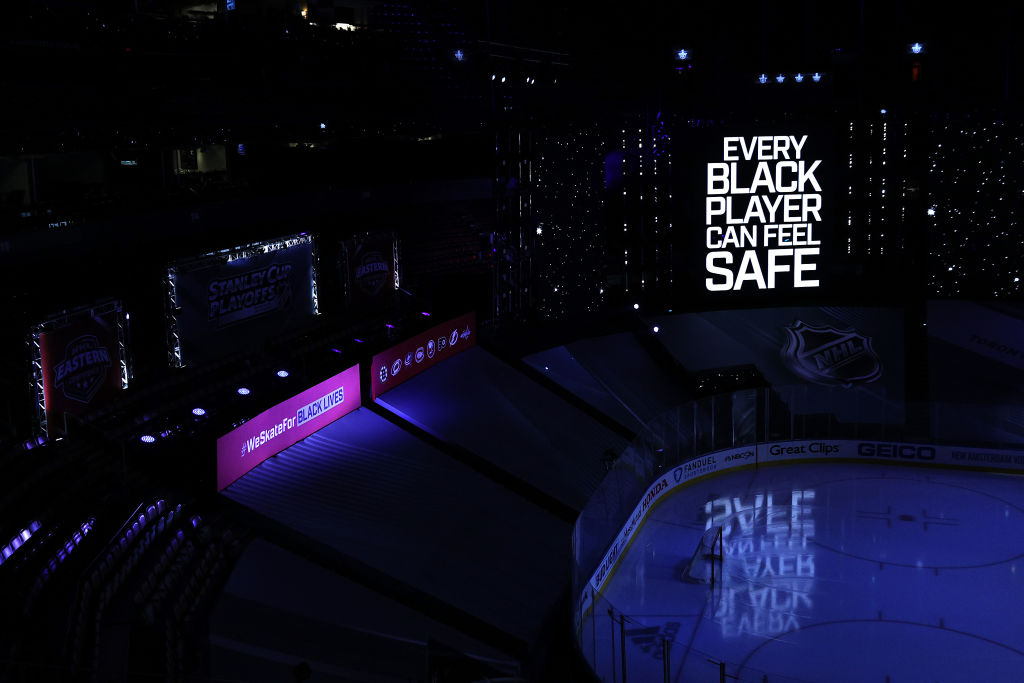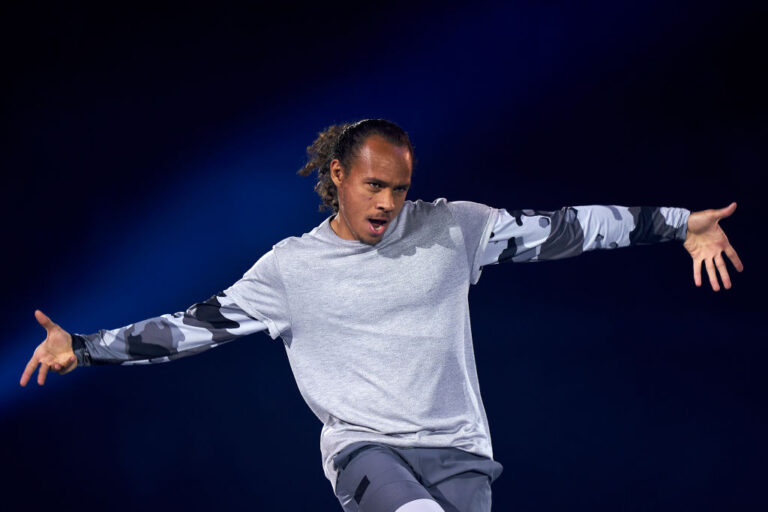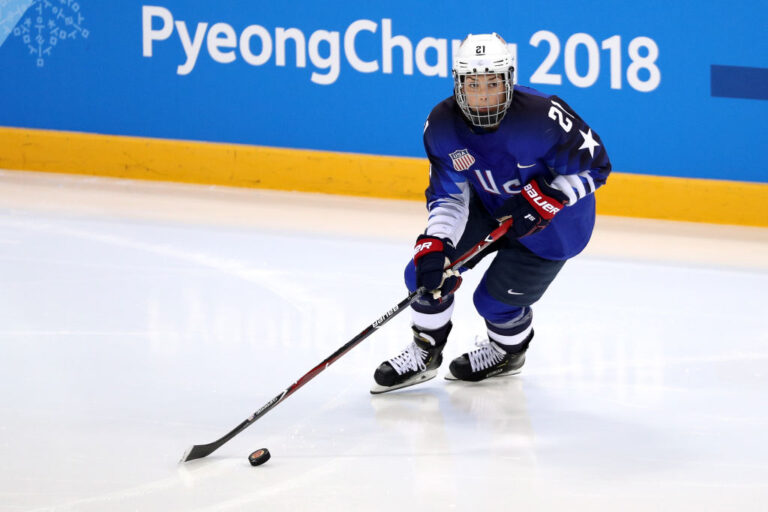'Let’s Take This as an Opportunity’: How Youth Hockey Is Curbing Racism
Why this matters
Hockey is a very White sport, and non-White athletes experience racism from the pro level all the way down to youth leagues. Here's how coaches and leaders in hockey are trying to help the game move forward.
Note: This story contains depictions of how racism affects the mental health of athletes and other people of Color.
When I was 14 or 15 years old, I was at football practice when a teammate walked up to me and called me the n-word. I was shocked. I also knew that going to my coaches would be little help to me when it came to this type of abuse. Growing up on South Side of Chicago in a home with two educators as well as family members who were in the Nation of Islam and the Black Panthers, I was constantly reminded about the horrors inflicted upon Black folks. So I handled things myself during a tackling drill by planting my right forearm into my teammate’s forehead.
Teammates saw an aggression they hadn’t seen before. I moved on, leaving what happened on the field.
One of the main reasons I co-wrote the book “Game Misconduct: Hockey Toxic Culture and How to Fix It” was because I didn’t want my daughter, who plays hockey, to internalize being the victim of racism the way I did.
I want things to be different for her. If she experiences anything like what I experienced, I want her to be able to tell a coach or referee about it – someone in a position of authority who will listen to her, have her back, and do what it takes to make things right. Given what I know about hockey culture, however, I can’t be sure that she won’t be left to fend for herself.
The sport’s ongoing issues with systemic racism are no secret. So when Black hockey parents like myself engage with White gatekeepers at the youth level, we usually want to know what they plan to do when (not if) our children are subjected to taunts and other forms of racism.
After an incident happens, after suspensions have been handed out, after any outrage has died down, what should players, parents, teams, and administrators do next? And can the sport do something more demonstrative than trotting out hashtag campaigns and mantra like the National Hockey League’s “racism has no place in this sport?”
Duante' Abercrombie believes that it can. A Washington, D.C. native and youth hockey administrator, he brought an idea to life that goes beyond condemnation and punishment: He attempted to rehabilitate a White player within his organization who directed a racial slur at a Black opponent.
Abercrombie, the director of player achievement for the Washington Little Caps, an Atlantic Youth Hockey League team for players 16 and younger, won’t say exactly what slur was used – but compared it to a similar to an incident involving former Arizona Coyotes prospect Jalen Smereck, who was taunted by an opposing player in the Ukrainian Hockey League with a gesture mimicking peeling a banana and eating it.
Abercrombie also said that the Little Caps player in question received separate suspensions from USA Hockey and his team, which features multiple players of Color.
“As there have been incidents all over the country, our hockey directors are very forward-thinking and said, ‘Let's get ahead of this,’’ Abercrombie explained. “‘Let's take this as an opportunity to be able to teach while these individuals are suspended.’
“No knock on USA Hockey but we move pretty quickly at this organization. And I said, ‘I have no problem stepping in knowing the triggering that would occur with me just being a young Black male who grew up in Washington, D.C.’”
By stepping in, Abercrombie understood that he was contributing to a long history of Black folks spearheading diversity, equity, and inclusion efforts within hockey while their White colleagues rarely participate in any of the heavy lifting. He was warned by others working in the anti-racism space in hockey not to expose himself to repeated trauma – that is, reminders of what opposing players used to say about him – and told that it was not his job to “fix someone else’s racism.”
Given the seriousness of the problem, however, Abercrombie was determined to try.
The Human Cost of Racism in Hockey
For hockey players of Color, the costs of racism and discrimination are high. Experiencing either places young people at greater risk of dealing with mental health problems. Racial discrimination also has been linked to anxiety and suicidality, as well as physical and behavioral health issues, such as cardiovascular problems and poor sleep.
Exclusion also is unhealthy for hockey as a whole: When children of Color experience racism or are made to feel unwelcome in the sport, they become more likely to take their talents elsewhere.
At the professional level, leagues and teams typically respond to racist incidents with formal fines and suspensions. Increasingly, offending players also are required to participate in programs that provide education and training on racism and inclusion.
For example, Jacksonville Icemen defenseman Jacob Panetta was suspended by the East Coast Hockey League for the remainder of the current season after making an alleged monkey gesture at South Carolina Stingrays defenseman Jordan Subban, who is Black. He was later reinstated following the "successful completion of a learning experience in conjunction with the [NHL’s] Player Inclusion Committee.”
Similarly, San Jose Barracuda winger Krystof Hrabik was suspended for 30 games this season for mimicking an ape in a gesture directed at Tucson Roadrunners winger Boko Imama, who is Black, and reinstated after participating in an education program.
Related: How High Costs and Low Representation Prevent Black Youth From Playing Baseball
What do these programs aim to accomplish? Do they attempt to foster reconciliation? The American Hockey League did not respond to my request to speak with both players. In a statement Hrabik sent to Sportsnet’s Elliotte Friedman during his suspension, he said that "people should know that I had absolutely no inappropriate intent. The gesture was made in the heat of battle and, while I didn't mean anything racist by what I did, I realize now through my own ignorance how my gesture could be interpreted.”
To me – and likely to many other players and parents of Color – a statement like “in the heat of the battle” reads, at best, as a cop-out. At worst, it comes across as a way of saying, “This is what I already believe.” Understanding more about what Hrabik learned during his suspension and how his attitude has (or hasn’t) changed could go a long way toward assuaging doubts that he was being sincere and not just saying what he felt he had to say in order to play again.
Meanwhile, youth players and families often find themselves relying on individual coaches to respond to racist incidents. In a 2020 column for NHL.com titled “Why I Raised My Fist,” former professional player J.T. Brown revealed how he was called the n-word by an opposing player during a youth game. He said the referee refused to remove that player from the game, leaving his coach and teammates to rally around him and leave the ice in protest.
“Those are the stories people like to hear because they offer resolution and a sense of community,” wrote Brown, a Minnesota native. “I usually don't talk about when I was at a house party in high school and some kids from school pulled out a shotgun and aimed it at my head as they were calling me the n-word. People don't like those stories because they reveal truths they choose to ignore.”
Meredith Lang, one of the founders of Minnesota Unbounded, a Minneapolis-based youth tournament team that showcases young girls of Color, said that the approach of Brown’s coach—standing up for a player of Color in a pivotal moment—is one that she would like to see emulated.
“Imagine that confidence boost and the trust that was built just during that one decision that the coach had made and how it positively impacted his career,” said Lang. “There are so many things that coach could have done differently. [Brown] could have said, ‘Hockey's not for me. I don't need to deal with this. I can go to another sport where I'm accepted.’”
Not all youth coaches are as quick to back players of Color. Lang recalls a separate incident in which another youth hockey players was called a racial slur by an opponent and the player was protected by the coach. “[There was] zero idea what to do,” she said. “The coach of the offending player said, ‘You know, I don’t think that she would ever say that. She’s crying.’ The coach suggested that the moms talk to each other and talk it over.”
To create accountability, Lang believes that youth organizations should provide coaches, players, and parents with formal anti-racist training prior to season play. A former youth player herself, she also thinks that youth organizations need to have plans in place to deal with racist incidents before they occur.
“I did level one and two training with USA Hockey to be a coach and it was hours upon hours of reading material and training, and then I had to sit in on a two-day seminar,” she said. “Not once was anything with cultural awareness talked about … and that's the easiest place to implement cultural awareness, so that people have an idea as far as what to do when something happens, because they don't know. “
‘What are You Going to Do to Make Sure it Doesn’t Happen Again?’
Abercrombie doesn’t shy away from creating cultural awareness. With the help of people including Kim Davis, the NHL’s executive vice president for social impact, growth initiatives and legislative affairs, he curated a “loose” plan to rehabilitate the offending Little Caps player. He says the player’s parents were on board with the plan, as were other parents.
The goal? Help the player become a better and more aware person. Don’t run away from what happened, or push the player into a defensive shell that leaves them stuck in their ways. Confront the incident, engage in uncomfortable conversations, and involve the entire team.
Related: A Conversation With Reggie Jackson on Baseball and Race
First, Abercrombie spoke in-depth with the player and his parents about the incident with the Little Caps. Next, coaches and players watched “13th” and “When They See Us” from Netflix to understand the intersection of systemic racism and mass incarceration in America’s criminal justice system. “That really hit home because [the offending player] was like, ‘It just sucks that there was a group of kids that were just being young and running around having a good time; they got racially profiled, and their lives were completely ruined,’” Abercrombie said.
Group discussions followed. “A question that I posed to the entire group was: ‘What is something that you have seen in the past where you wish you would have spoken up, but you didn't?’” said Abercrombie.
“And obviously being the age that they are, some of them spoke up and some didn't – and that's perfectly fine. We also did an exercise that I thought worked very well where we wrote down three things that we wish our teammates knew about us.
“Now they have an understanding of what individuals in their own locker room are dealing with on a day-to-day basis. It was a very powerful moment for those kids. I still remember the tears … That little moment of stepping up or advocating for or having a sense of accountability for not just your actions, but your ability to speak and and voice your opinions, was pretty cool. I wasn't expecting it from that age group.”
Abercrombie said that he has attempted to start a dialogue with the player who was taunted, but that those efforts have gone unanswered. He also said that the offending player spent some time with the Fort Dupont Cannons, a Washington-based youth team composed of Black players.
“My reason for [establishing a relationship with the Cannons] was you can't just go out into a one-off and say, ‘Hey, we helped some kids from the ‘hood and then we go back to our home with a five-car garage,’” he said. “My hope was that they go in, they learn some names, and they build some relationships.”
Ultimately, Abercrombie said, he believes in sustainable accountability—in responding to racism in youth hockey instead of simply reacting. “I think people can say, ‘Hey, that's wrong. That shouldn't happen,’” he said. “‘But what are you doing to make sure it doesn't happen again?’”
Please see our list of Mental Health Resources if you are seeking information or assistance regarding mental health.
Monthly Issue
Mental Health: A New Priority in Sport
Athletes continue to tell us they are not OK with their actions and words. In response, the sports industry has acknowledged it can and should be doing more to support the people who are its lifeblood, from athletes to coaches and beyond.
Sport is both reckoning with its roots, uncovering how history and habit created circumstances that don’t suit everyone who competes, as well as navigating new territory during a time of unprecedented strain on our mental well-being. By making mental health a priority, sport has an opportunity to confer a host of benefits supporting mental wellness and to be more safe, inclusive, and inspiring.




